<> Papilio helenus Linnaeus, 1758 <>
the Red Helen ผีเสื้อหางติ่งเฮเลน
Click on any photo to see all photos full size in Lightbox
Additions and corrections to the information provided on this page is always welcome. Please use the Contact form.
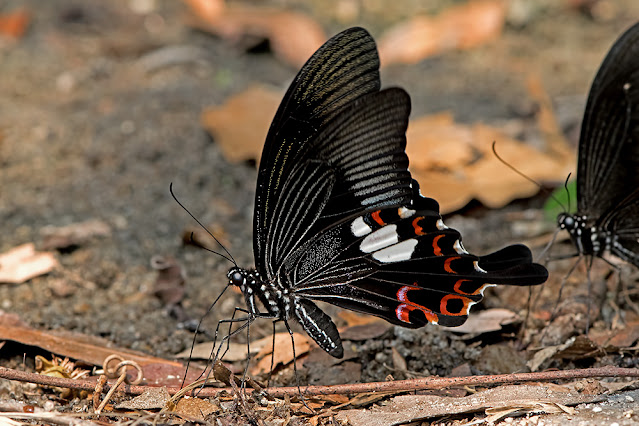
Photo taken at Doi Suthep-Pui National Park, Chiang Mai, Thailand. 450m a.s.l.

A large swallowtail found in nearly all countries across the region from the Himalayas to the islands of Indonesia and the Philippines. Strangely, no colonies have been found in Singapore even though the species is abundant in neighbouring Malaysia. It is not dimorphic and the sexes look alike, although the female is larger than the male. It is primarily a forest species and rarely ventures onto arable land or into urban areas.
Papilio helenus is a strong flier and males are very territorial, chasing away any intruding butterflies. The males are also avid mud puddlers and are seen regularly along the banks of streams. The species is multivoltine with several broods per annum. Its larvae usually feed at night and are inactive during the day. The pupae can be either green or brown in colour.
Synonyms and previously used names: Charus helenus, Menelaides helenus
Taxonomy: Animalia - Arthropoda - Insecta - Lepidoptera - Papilionidae - Papilioninae - Papilio - helenus
Regional subspecies: Papilio helenus fortunius (Taiwan), P.helenus helenus (N.India, Nepal, Myanmar, Thailand, Laos, Cambodia, Vietnam, China, W.Malaysia, Singapore).
Regional Distribution: India, Nepal, Bhutan, Bangladesh, Myanmar, Thailand, Laos, Cambodia, Vietnam, China, Taiwan, Malaysia, Singapore
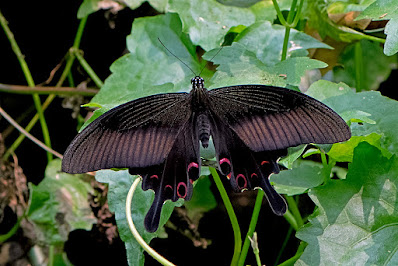 |
Doi Suthep-Pui National Park, Chiang Mai, Thailand. 450m a.s.l. |
Habitat: This species is found in a wide range of evergreen and deciduous forest habitats including bamboo. They appear to favour areas near streams and rivers surrounded by dense vegetation at moderate elevations but up to 3000m in the Himalayas.
Flight time: all year, depending on location. Wingspan: 90-120mm
Life History: egg 4-7 days instar 1 4-5 days instar 2 3-4 days instar 3 4-5 days instar 4 4-5 days instar 5 5 days pupa 13-14 days Total egg-adult 38-45 days
All times are approximate and can vary depending on the season and on the host used.
Larval Hosts: Atalantia buxifolia, Citrus x aurantium, Citrus japonica, Citrus x limon, Citrus maxima, Citrus medica, Citrus reticulata, Citrus x tachibana, Citrus trifoliata, Clausena harmandiana, Clausena heptaphylla, Clausena lansium, Glycosmis parviflora, Glycosmis pentaphylla, Phellodendron amurense, Tetradium fraxinifolium, Tetradium glabrifolium, Zanthoxylum acanthopodium, Zanthoxylum ailanthoides, Zanthoxylum asiaticum, Zanthoxylum avicennae, Zanthoxylum myriacanthum, Zanthoxylum nitidum, Zanthoxylum rhetsa, Zanthoxylum scandens, Zanthoxylum tetraspermum (Rutaceae).
Actual host plant used depends upon location and availabilty of plant species.
Adult Food Sources: Nectar - Hedyotis fruticosa, Ixora coccinea, Ixora javanica, Ixora chinensis, Mussaenda frondosa, Pentas lanceolata (Rubiaceae), Lantana camara, Stachytarpheta urticifolia (Verbenaceae), Clerodendrum bungei, Clerodendrum infortunatum (Lamiaceae), Cestrum elegans (Solanaceae), Passiflora ligularis (Passifloraceae), Asystasia chelonoides (Acanthaceae), Ageratina riparia, Bidens alba (Asteraceae), Cheniella corymbosa, Cheniella glauca (Fabaceae), Hibiscus hirtus, Urena lobata (Malvaceae), Cyananthus incanus (Campanulaceae), Rhododendron falconeri (Ericaceae), Gentiana capitata (Gentianaceae), Magnolia campbellii (Magnoliaceae), Coelogyne corymbosa (Orchidaceae), Fragaria nubicola, Prunus cerasoides (Rosaceae). Other - mud puddling, animal dung, carrion (mainly fish and crabs)
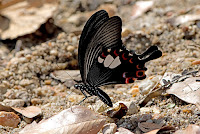 |
| Doi Suthep-Pui National Park, Chiang Mai, Thailand |
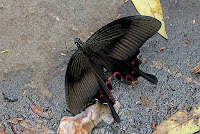 |
| Doi Suthep-Pui National Park, Chiang Mai, Thailand |
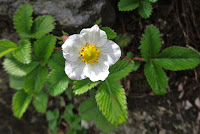 |
| Fragaria nubicola, a nectar source |
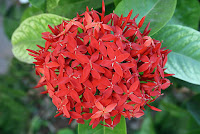 |
| Ixora coccinea, another nectar source |
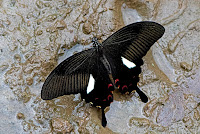 |
| Chiang Dao Nature Sanctuary, Chiang Mai, Thailand |
 |
| Doi Suthep-Pui National Park, Chiang Mai, Thailand |
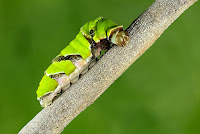 |
| 5th instar larva shortly before pupation |
 |
| pupa |
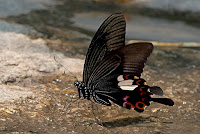 |
| Doi Suthep-Pui National Park, Chiang Mai, Thailand |
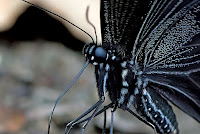 |
| Doi Suthep-Pui National Park, Chiang Mai, Thailand |
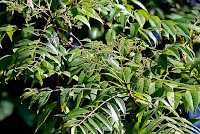 |
| Tetradium glabrifolium, a larval host |
 |
| Glycosmis pentaphylla, another larval host |
Links to other pages in this series for species in the same subfamily
Graphium nomius
Papilio agenor
Papilio helenus
Troides helena
